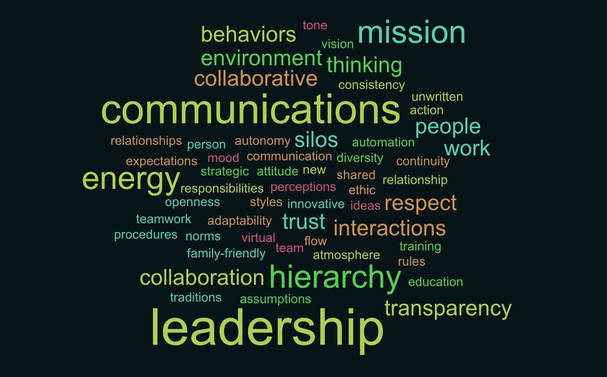Mission: Impact podcast & blog
Build a better world without becoming a martyr to your nonprofit cause
Listen on:
 for At the American Society for Association Executive (ASAE)’s At Work conference in early October, I facilitated a session on cultivating a healthy organizational culture for your nonprofit organization. When asked what they associated with the term organizational culture, participants had lots of responses. Values, communications, hierarchy and energy were mentioned most frequently. The word cloud to the left summarizes the variety of responses. DefinitionsOrganizational culture, as defined by Edgar Schein, is “a pattern of shared basic assumptions that the group learned as it solved its problems of external adaptation and internal integration, that has worked well enough to be considered valid and, therefore, to be taught to new members as the correct way you perceive, think, and feel in relation to those problems.” While there are visible parts of culture such as dress code, the organization’s mission, work environment, policies and procedures and strategic statements, most of culture in implicit and not readily visible. It has to be learned. This could be through story and conversation or more powerfully by making mistakes that break unspoken rules and assumptions. One organizational culture modelHuman Synergistics International’s Organizational Culture inventory is a commonly used organizational assessment that uncovers an organization’s cultural style. They group cultures in three styles, including constructive, passive/defensive and aggressive/defensive. A constructive culture, in their model, supports achievement, self-actualization and encourages people within the organization to work cooperatively with each other. A passive/defensive culture encourages people to follow the rules, values dependability, solutions tend to be conventional and conflict is avoided. An aggressive/defensive style values people who vie for status and influence by challenging each other, by taking charge and compete with each other. This style also tends to celebrate perfectionism and long hours. Of these three styles, the constructive style (not surprising considering its name!) is the healthiest culture and is most closely correlated with deeper employee engagement and better organizational results. What do healthy organizations do differently?Having used this assessment with many of her nonprofit clients, Dr. Elizabeth Scott researched what nonprofit organizations that have a healthy culture do differently than their peers with less healthy organizational cultures. She found that these organizations take distinctive action in two major areas – people practices and employee wellbeing and empowerment. Some specific actions that they take include infusing fun into their work, focusing on self-care and work-life balance and empowering staff to carry out the mission on their own. In terms of their human resources practices, they see human resources staff as a partner, they engage in careful hiring, onboarding as well as off boarding when needed. They provide ongoing training and regular feedback and place an emphasis on teamwork. Cultivating a healthy cultureI asked participants in the session what their organization was doing in the areas of people practices and employee wellbeing and empowerment. Some current steps in people practices that people mentioned include new employee welcome and mentoring program, a new idea generation group that meet regularly, every other Friday off, employee engagement surveys and committees, staff retreats and telecommuting options. For encouraging employee well being, people mentioned fun committees, culture committees, book groups, gym reimbursement, movie day and other wellness initiatives. Intention & leadership supportWhat I appreciate about most of these ideas is that for the most part they are not costly. What they require is intention and support from leadership. Support for people to take the time to come together and plan fun activities as well as the time and permission within the culture for people to participate. PermissionThat permission is key. I have seen organization that have tried some of these things – putting a foosball table and other board games in the lunch room for example. Yet the culture valued quiet and the CEO was known to publically question people when they took a break. So very few people used the foosball table or the games because it went against both unspoken and spoken ‘rules” within the culture. Other examples include organizations that have elaborate telecommuting policies or flexible leave policies that few take advantage of because face time and being seen in the office is highly valued.
What of these ideas could your organization try? And if you do – how will you make sure people know they really have permission to engage! Does your organization’s culture need some attention? Inquire about a coaching call. Comments are closed.
|
Categories
All
Archives
July 2024

Grace Social Sector Consulting, LLC, owns the copyright in and to all content in and transcripts of the Mission: Impact podcast, as well as the Mission: Impact blog with all rights reserved, including right of publicity.
|
Telephone301-857-9335
|
info[at]gracesocialsector.com
|
Grace Social Sector Consulting, LLC, owns the copyright in and to all content in, including transcripts and audio of the Mission: Impact podcast and all content on this website, with all rights reserved, including right of publicity.
|